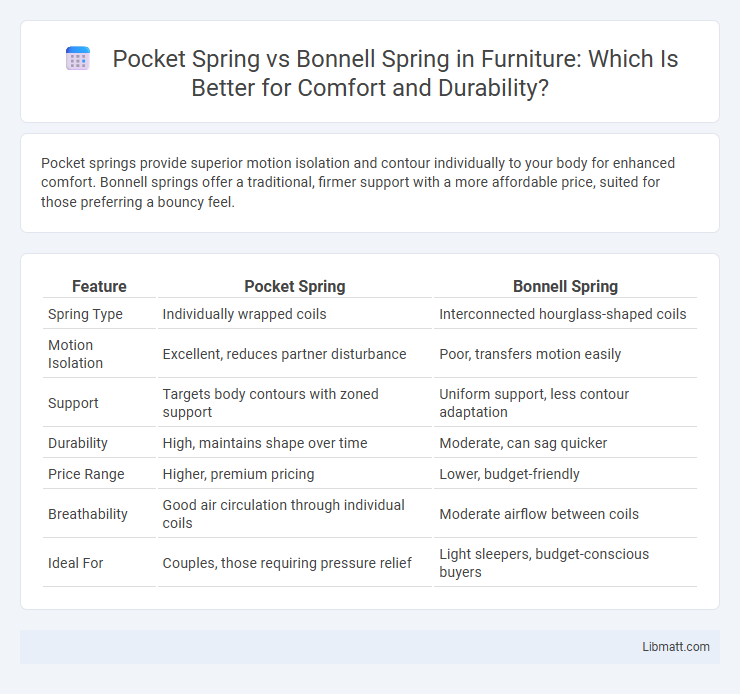Pocket springs provide superior motion isolation and contour individually to your body for enhanced comfort. Bonnell springs offer a traditional, firmer support with a more affordable price, suited for those preferring a bouncy feel.
Table of Comparison
| Feature | Pocket Spring | Bonnell Spring |
|---|---|---|
| Spring Type | Individually wrapped coils | Interconnected hourglass-shaped coils |
| Motion Isolation | Excellent, reduces partner disturbance | Poor, transfers motion easily |
| Support | Targets body contours with zoned support | Uniform support, less contour adaptation |
| Durability | High, maintains shape over time | Moderate, can sag quicker |
| Price Range | Higher, premium pricing | Lower, budget-friendly |
| Breathability | Good air circulation through individual coils | Moderate airflow between coils |
| Ideal For | Couples, those requiring pressure relief | Light sleepers, budget-conscious buyers |
Introduction to Pocket Spring and Bonnell Spring Mattresses
Pocket spring mattresses feature individually wrapped coils that move independently, providing targeted support and reducing motion transfer for improved sleep quality. Bonnell spring mattresses consist of interconnected hourglass-shaped coils, offering a firmer feel with evenly distributed support but less contouring ability. Choosing between pocket spring and Bonnell spring mattresses depends on preferences for pressure relief, motion isolation, and mattress firmness.
Construction Differences: Pocket Spring vs Bonnell Spring
Pocket springs feature individual coils wrapped separately in fabric pockets, allowing each spring to operate independently and provide targeted support. Bonnell springs consist of hourglass-shaped wire coils interconnected with a mesh, offering a more uniform bounce and less contouring to body shape. Your choice between pocket spring and Bonnell spring construction affects mattress durability, motion isolation, and overall comfort responsiveness.
Comfort and Support Comparison
Pocket spring mattresses provide superior comfort and support by allowing each spring to move independently, contouring to the body's shape and reducing motion transfer. Bonnell spring mattresses offer a firmer feel with interconnected springs that distribute weight evenly but may cause pressure points due to less individual responsiveness. The pocket spring design excels in targeted support and maintaining spinal alignment, while Bonnell springs are more durable but less adaptive to body curves.
Motion Isolation: Which Performs Better?
Pocket spring mattresses outperform Bonnell spring models in motion isolation due to their individually wrapped coils that absorb movement independently, minimizing disturbance across the bed. Bonnell springs, interconnected by a wire frame, tend to transfer motion more readily, resulting in noticeable vibrations when one person moves. This makes pocket springs the preferred choice for couples seeking reduced motion transfer and a quieter sleep experience.
Durability and Longevity
Pocket springs offer superior durability and longevity due to their individually wrapped coils that reduce wear and maintain consistent support over time. Bonnell springs, with their interconnected hourglass-shaped coils, tend to lose shape and sag faster because of uniform pressure distribution. High-quality pocket spring mattresses typically last 7-10 years, whereas Bonnell spring mattresses often require replacement after 5-7 years.
Breathability and Temperature Regulation
Pocket springs provide superior breathability and temperature regulation due to their individually wrapped coils that allow better airflow compared to Bonnell springs, which have interconnected coils that restrict ventilation. The enhanced airflow in pocket spring mattresses helps dissipate heat and moisture, promoting a cooler sleep environment. Your choice between the two should consider the importance of maintaining a comfortable temperature throughout the night.
Price Comparison: Pocket Spring vs Bonnell Spring
Pocket spring mattresses typically cost more than Bonnell spring mattresses due to their advanced construction, which offers superior support and motion isolation. Bonnell springs, made with hourglass-shaped coils, provide a more affordable option but may lack the ergonomic benefits found in pocket spring designs. Your choice depends on budget constraints and the desired balance between comfort and price.
Suitability for Different Sleepers
Pocket springs offer individualized support by contouring to each sleeper's body, making them ideal for side and combination sleepers who need targeted pressure relief. Bonnell springs provide a more uniform and firmer feel, suiting back and stomach sleepers who prefer consistent support across the mattress surface. The motion isolation advantage of pocket springs also benefits couples, reducing disturbance from partner movements.
Pros and Cons Summary
Pocket springs offer superior motion isolation and personalized support due to individually wrapped coils, reducing partner disturbance and enhancing comfort. Bonnell springs provide durability and firm support with a traditional hourglass shape but may transfer motion more easily, making them less ideal for couples. Your choice depends on whether you prioritize targeted comfort and minimal motion transfer with pocket springs or affordability and robust support with Bonnell springs.
How to Choose Between Pocket and Bonnell Spring Mattresses
Choosing between pocket spring and Bonnell spring mattresses depends on your preference for support and motion isolation; pocket springs individually encased in fabric provide targeted support and minimize motion transfer, ideal for couples. Bonnell spring mattresses feature interconnected coils offering firm support and durability, suitable for those seeking a traditional, bouncy feel at a lower price point. Consider factors like sleeping position, body weight, and budget to determine which spring system aligns best with your comfort needs and longevity expectations.
pocket spring vs bonnell spring Infographic

 libmatt.com
libmatt.com